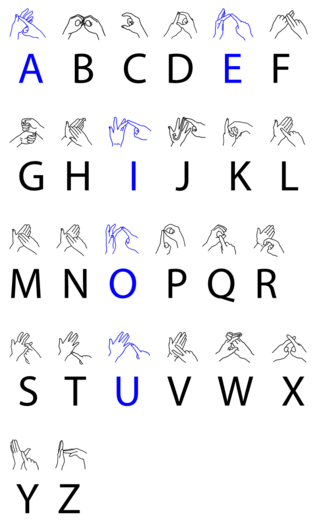
American Sign Language (ASL), is a natural language that serves as the predominant sign language of Deaf communities in the United States of America and most of Anglophone Canada. ASL is a complete and organized visual language that is expressed by employing both manual and nonmanual features. Besides North America, dialects of ASL and ASL-based creoles are used in many countries around the world, including much of West Africa and parts of Southeast Asia. ASL is also widely learned as a second language, serving as a lingua franca. ASL is most closely related to French Sign Language (LSF). It has been proposed that ASL is a creole language of LSF, although ASL shows features atypical of creole languages, such as agglutinative morphology.

Sign languages are languages that use the visual-manual modality to convey meaning, instead of spoken words. Sign languages are expressed through manual articulation in combination with non-manual markers. Sign languages are full-fledged natural languages with their own grammar and lexicon. Sign languages are not universal and are usually not mutually intelligible, although there are also similarities among different sign languages.

British Sign Language (BSL) is a sign language used in the United Kingdom (UK), and is the first or preferred language among the Deaf community in the UK. Based on the percentage of people who reported 'using British Sign Language at home' on the 2011 Scottish Census, the British Deaf Association estimates there are 151,000 BSL users in the UK, of which 87,000 are Deaf. By contrast, in the 2011 England and Wales Census 15,000 people living in England and Wales reported themselves using BSL as their main language. People who are not deaf may also use BSL, as hearing relatives of deaf people, sign language interpreters or as a result of other contact with the British Deaf community. The language makes use of space and involves movement of the hands, body, face, and head.
The three models of deafness are rooted in either social or biological sciences. These are the cultural model, the social model, and themedicalmodel. The model through which the deaf person is viewed can impact how they are treated as well as their own self perception. In the cultural model, the Deaf belong to a culture in which they are neither infirm nor disabled, but rather have their own fully grammatical and natural language. In the medical model, deafness is viewed undesirable, and it is to the advantage of the individual as well as society as a whole to "cure" this condition. The social model seeks to explain difficulties experienced by deaf individuals that are due to their environment.

Martha's Vineyard, often simply called the Vineyard, is an island in the Northeastern United States, located south of Cape Cod in Dukes County, Massachusetts, known for being a popular, affluent summer colony. Martha's Vineyard includes the smaller adjacent Chappaquiddick Island, which is usually connected to the Vineyard. The two islands have sometimes been separated by storms and hurricanes, which last occurred from 2007 to 2015. It is the 58th largest island in the U.S., with a land area of about 96 square miles (250 km2), and the third-largest on the East Coast, after Long Island and Mount Desert Island. Martha's Vineyard constitutes the bulk of Dukes County, which also includes the Elizabeth Islands and the island of Nomans Land.
A spoken language is a language produced by articulate sounds or manual gestures, as opposed to a written language. An oral language or vocal language is a language produced with the vocal tract in contrast with a sign language, which is produced with the body and hands.
Deaf-mute is a term which was used historically to identify a person who was either deaf and used sign language or both deaf and could not speak. The term continues to be used to refer to deaf people who cannot speak an oral language or have some degree of speaking ability, but choose not to speak because of the negative or unwanted attention atypical voices sometimes attract. Such people communicate using sign language. Some consider it to be a derogatory term if used outside its historical context; the preferred term today is simply deaf.
Nicaraguan Sign Language is a form of sign language which developed spontaneously among deaf children in a number of schools in Nicaragua in the 1980s. It is of particular interest to linguists as it offers them a unique opportunity to study what they believe to be the birth of a new language.
Auslan is the majority sign language of the Australian Deaf community. The term Auslan is a portmanteau of "Australian Sign Language", coined by Trevor Johnston in the 1980s, although the language itself is much older. Auslan is related to British Sign Language (BSL) and New Zealand Sign Language (NZSL); the three have descended from the same parent language, and together comprise the BANZSL language family. Auslan has also been influenced by Irish Sign Language (ISL) and more recently has borrowed signs from American Sign Language (ASL).
Martha's Vineyard Sign Language (MVSL) was a village sign-language that was once widely used on the island of Martha's Vineyard from the early 18th century to 1952. It was used by both deaf and hearing people in the community; consequently, deafness was not a barrier to participation in public life. Deaf people who signed Martha's Vineyard Sign Language were extremely independent.
Adamorobe Sign Language or Adasl is a village sign language used in Adamorobe, an Akan village in eastern Ghana. It is used by about 30 deaf and 1370 hearing people (2003).

Manualism is a method of education of deaf students using sign language within the classroom. Manualism arose in the late 18th century with the advent of free public schools for the deaf in Europe. These teaching methods were brought over to the United States where the first school for the deaf was established in 1817. Today manualism methods are used in conjunction with oralism methods in the majority of American deaf schools.
The recorded history of sign language in Western societies starts in the 17th century, as a visual language or method of communication, although references to forms of communication using hand gestures date back as far as 5th century BC Greece. Sign language is composed of a system of conventional gestures, mimic, hand signs and finger spelling, plus the use of hand positions to represent the letters of the alphabet. Signs can also represent complete ideas or phrases, not only individual words.
Ka'apor Sign Language was a village sign language used by the small community of Ka'apor people in the Brazilian state of Maranhão. Linguist Jim Kakumasu observed in 1968 that the number of deaf people in the community was 7 out of a population of about 500. This relatively high ratio of deafness led to both hearing and deaf members of the community using the language, and most hearing children grow up bilingual in the spoken and signed languages. The current state of the language is unknown. Other Indigenous tribes in the region have also been reported to use sign languages, and to communicate between themselves using sign language pidgins.
In the United States, deaf culture was born in Connecticut in 1817 at the American School for the Deaf, when a deaf teacher from France, Laurent Clerc, was recruited by Thomas Gallaudet to help found the new institution. Under the guidance and instruction of Clerc in language and ways of living, deaf American students began to evolve their own strategies for communication and for living, which became the kernel for the development of American Deaf culture.
The Centre for Deaf Studies was a department of the University of Bristol, England, in the field of deaf studies, which it defines as the study of the "language, community and culture of Deaf people". Established in 1978, the Centre claimed to be the first higher educational Institute in Europe "to concentrate solely on research and education that aims to benefit the Deaf community". The centre was at the forefront in establishing the disciplines of deaf studies and deafhood. It used British Sign Language (BSL), had a policy of bilingual communication in BSL and English, and employed a majority of deaf teaching staff.
A village sign language, or village sign, also known as a shared sign language, is a local indigenous sign language used by both deaf and hearing in an area with a high incidence of congenital deafness. Meir et al. define a village sign language as one which "arise[s] in an existing, relatively insular community into which a number of deaf children are born." The term "rural sign language" refers to almost the same concept. In many cases, the sign language is known throughout the community by a large portion of the hearing population. These languages generally include signs derived from gestures used by the hearing population, so that neighboring village sign languages may be lexically similar without being actually related, due to local similarities in cultural gestures which preceded the sign languages. Most village sign languages are endangered due to the spread of formal education for the deaf, which use or generate deaf-community sign languages, such as a national or foreign sign language.
The sociolinguistics of sign languages is the application of sociolinguistic principles to the study of sign languages. The study of sociolinguistics in the American Deaf community did not start until the 1960s. Until recently, the study of sign language and sociolinguistics has existed in two separate domains. Nonetheless, now it is clear that many sociolinguistic aspects do not depend on modality and that the combined examination of sociolinguistics and sign language offers countless opportunities to test and understand sociolinguistic theories. The sociolinguistics of sign languages focuses on the study of the relationship between social variables and linguistic variables and their effect on sign languages. The social variables external from language include age, region, social class, ethnicity, and sex. External factors are social by nature and may correlate with the behavior of the linguistic variable. The choices made of internal linguistic variant forms are systematically constrained by a range of factors at both the linguistic and the social levels. The internal variables are linguistic in nature: a sound, a handshape, and a syntactic structure. What makes the sociolinguistics of sign language different from the sociolinguistics of spoken languages is that sign languages have several variables both internal and external to the language that are unique to the Deaf community. Such variables include the audiological status of a signer's parents, age of acquisition, and educational background. There exist perceptions of socioeconomic status and variation of "grassroots" deaf people and middle-class deaf professionals, but this has not been studied in a systematic way. "The sociolinguistic reality of these perceptions has yet to be explored". Many variations in dialects correspond or reflect the values of particular identities of a community.
Nora Ellen Groce is an anthropologist, global health expert and Director of the Disability Research Centre at University College London. She is known for her work on vulnerable populations in low- and middle-income countries and in particular for her work on people with disabilities in the developing world. Her doctoral dissertation, published by Harvard University Press in 1985, Everyone Here Spoke Sign Language: Hereditary Deafness on Martha’s Vineyard, is considered a classic work in the disability studies and ethnographic literatures.




